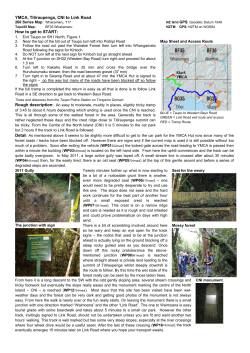
Space and Missile Systems Center Global Positioning Systems Directorate GPS Program Update to
Space and Missile Systems Center Global Positioning Systems Directorate GPS Program Update to 8th Stanford PNT Symposium 30 Oct 2014 Col Matt Smitham Deputy Director, GPS Directorate Global Positioning Systems Directorate SPACE AND MISSILE SYSTEMS CENTER Mission: Acquire, deliver and sustain reliable GPS capabilities to America’s warfighters, our allies, and civil users Col Bill Cooley Deliver and Sustain Global Navigation and Timing Service GPS Overview SPACE AND MISSILE SYSTEMS CENTER Civil Cooperation • 1+ Billion civil & commercial users • Search and Rescue • Civil Signals – L2C (2nd Civil Signal) – L5 (Safety of Life) – L1C (International) Spectrum • World Radio Conference • International Telecommunication Union • Bilateral Agreements • Adjacent Band Interference Department of Defense • Services (Army, Navy, AF, USMC) • Agencies (NGA & DISA) • US Naval Observatory • PNT EXCOMS • GPS Partnership Council 38 Satellites / 31 Set Healthy Baseline Constellation: 24 Satellites Satellite Block GPS IIA GPS IIR GPS IIR-M GPS IIF Constellation Quantity Average Age 5 20.5 12 12.8 7 7.2 7 1.8 31 10.3 Oldest 23.9 17.2 9.1 4.4 23.9 Maintenance/Security • All Level I and Level II – Worldwide Infrastructure – NATO Repair Facility • Develop & Publish ICDs Annually – ICWG: Worldwide Involvement • Update www.GPS.gov Webpage • Load Operational Software on over 1 million SAASM Receivers • Distribute PRNs for the World – Including 90 for GNSS AS OF 21 OCT 14 Department of Transportation • Federal Aviation Administration Department of Homeland Security • U.S. Coast Guard International Cooperation • 57 Authorized Allied Users – 25+ Years of Cooperation • GNSS – Russia - GLONASS – Europe - Galileo – China - BeiDou – Japan - QZSS – India - IRNSS GPS Signal-in-Space Performance SPACE AND MISSILE SYSTEMS CENTER Standard Positioning Service (SPS) Signal-in-Space Performance Standard Positioning Service (SPS) Signal-in-Space Performance Precise Positioning Service (PPS) Signal-in-Space Performance Precise Positioning Service (PPS) Signal-in-Space Performance Best performance 46.6 cm User Range Error (URE) 8 Jun 13; best weekly average 58.7 cm URE 18 Aug 14! GPS Performance – Past 12 Months SPACE AND MISSILE SYSTEMS CENTER GPS III Status SPACE AND MISSILE SYSTEMS CENTER • Newest block of GPS satellites – 4 civil and 4 military signals: L1 C/A, L1C, L2C, L5; L1/L2 P(Y), L1/L2M – First satellites to broadcast common L1C signal – Three improved Rubidium atomic clocks • SV07/08 contract awarded 31 Mar 14 • Navigation payload panel began space environment testing at Lockheed Martin’s Colorado facility Sep 2014 • GPS III Non-Flight Satellite Testbed accomplished launch processing at Cape Canaveral; reduced risk for integration & test and launch processing • GPS III SV01 available for launch starting 2016 Lockheed-Martin (Waterton, CO) – Prime Ground Segment Status SPACE AND MISSILE SYSTEMS CENTER • Current system Operational Control Segment (OCS) – Flying GPS constellation on Architecture Evolution Plan (AEP) and Launch & Early Orbit, Anomaly, and Disposal Operations (LADO) software systems – Cyber security enhancements in progress • Next Generation Operational Control System (OCX) Monitor Station – Modernized command & control system with M-Code, modern civil, signal monitoring, info assurance infrastructure and improved PNT performance – OCX Block 0 supports launch & checkout for GPS III and is in integration & test; Raytheon (Aurora, CO) - Prime – OCX Block 1 supports transition from OCS in 2018 – Successfully completed 3 GPS III launch exercises Ground Antenna Now on The Air: Modernized Civil Signals SPACE AND MISSILE SYSTEMS CENTER • The United States Air Force initiated continuous CNAV message broadcast (L2C & L5) on 28 Apr 14 • CNAV Data message uploaded twice a week; daily by Dec 2014 • Position accuracy not guaranteed during pre-operational deployment – L2C message currently set “healthy” – L5 message set “unhealthy” until sufficient monitoring capability established • Expected Performance for users: – During first 24 hours after upload, CNAV performs as LNAV – Expect divergence between CNAV & LNAV as CNAV data ages until next CNAV upload Effect of Upload Frequency on CNAV User Range Error SPACE AND MISSILE SYSTEMS CENTER • Improved tools reduce age of data & CNAV User Ranging Error (URE) • Initial, twice-a-week upload (Apr 2014) drives high CNAV URE RMS URET across CNAV-Capable SVs (meters) RMS URE Driven by Upload Latency & Integration with AEP 1.414 1.6 1.4 1.2 1 0.513 0.8 0.495 0.6 0.4 0.2 0 CNAV (3 Uploads/SV/Week) Legacy Navigation (LNAV) CNAV (Daily upload using tools integrated w/AEP) Challenge to the world-wide community: What are you seeing? How are you using these signals? Do these signals impact your use of codeless access? 9 Questions? SPACE AND MISSILE SYSTEMS CENTER For more information, please visit our homepage at www.gps.gov
© Copyright 2025













